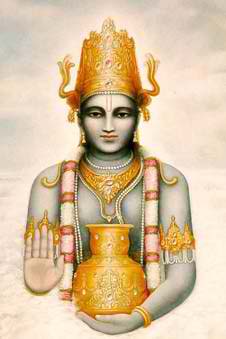Ayurveda reiki

"Ayu" means life and "Veda" means knowledge from the Vedic texts. This holistic science is the knowledge of complete balance of the Body, Mind and Spirit, including emotions and psychology, on all levels. Ayurveda includes in its consideration, longevity, rejuvenation and self-realization therapies through herbs, diet, exercise, yoga, aromas, tantras, mantras, and meditation.
It is said to have originated from Lord Brahma (Creator of the Universe, according to Indian mythology) and descended to the earth through various generations of gods and saints. The sage-physician- surgeons of the time were the same sages or seers, deeply devoted holy people, who saw health as an integral part of spiritual life. It is said that they received their training of Ayurveda through direct cognition during meditation. In other words, the knowledge of the use of various methods of healing, prevention, longevity and surgery came through Divine revelation(Cosmic Intelligence); there was no guessing or testing and
harming animals. These revelations were transcribed from the oral tradition into book form, interspersed with the other aspects of life and spirituality. Ayurveda is an ancient science of life, a traditional and the oldest and most holistic medical system available on the planet today. Its major premise involves the symbiosis of mind, body and spirit. Any imbalance in this synthesis results in physical ailments. This ancient Indian medicine seeks to reestablish the harmony between the body and its habitat. It was placed in written form over 5,000 years ago in India, it was said to be a world medicine dealing with both body and the spirit. Before the advent of
writing, the ancient wisdom of this healing system was a part of the spiritual tradition of the Vedic Religion.
This has been handed down to us by means of ancient venerable scripts as palm leaf books, leather leaves, etc. The oldest works in Ayurveda still available are the Charaka Samhita, Susrutha Samhita and Ashtanga Samgraha.
Basic Concepts of Ayurveda
The knowledge consists of three aspects known as the Tri-Sutras of ayurveda, which are - etiology or the science of the causes of disease, symptomatology or the study and interpretation of symptoms and medication and herbal remedies.
Vyaadhi, or disease in Ayurveda is due to an imbalance of three fundamental elements of the body.
These are VATA, PITTA and KAPHA.
The entire universe is made up of Panch Maha bhootas, or great "elements" . (which are not material in the usual sense of the term, and are types of energy.) For identifying them they are called
Akaasa ( space) Vaayu ( air ) Agni (fire )
Ap ( water ) Prithvi( earth )
Panch Maha bhootas are omnipresent, they are mixed in an infinite variety of relative proportions such that each form of matter is distinctly unique. Although each element has a range of attributes, only some get evident in particular situations. Constantly changing and interacting with each other, they create a situation of dynamic flux that keeps the world going.
Just as in nature, we too have these five elements in us. When any of these elements are present in the environment, they will in turn have an influence on us. While we are a composite of these five primary elements, certain elements are seen to have an ability to combine to create various physiological functions.
Within a simple, single living cell for example the earth element predominates by giving structure to the cell. The water element is present in the cytoplasm or the liquid within the cell membrane. The fire element regulates the metabolic processes regulating the cell. While the air element dominates the gases therein. The space occupied by the cell denoting the last of the elements.
The Panchmahabhootas therefore serve as the foundation of all diagnosis & treatment modalities in Ayurveda and has served as a most valuable theory for physicians to detect and treat illness of the body and mind successfully.
